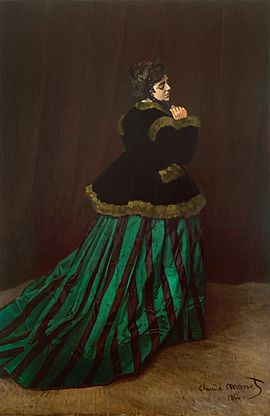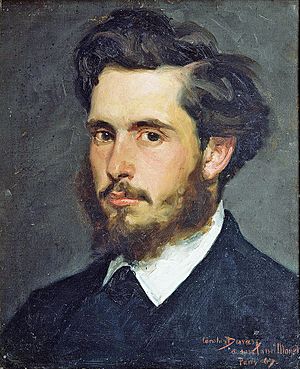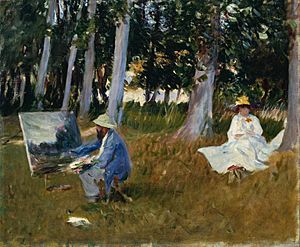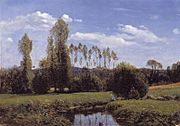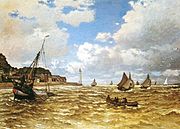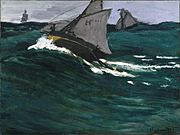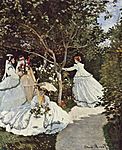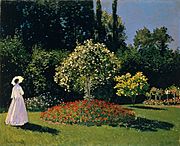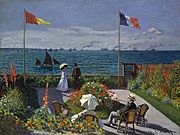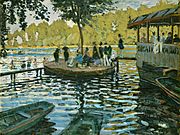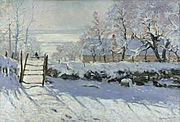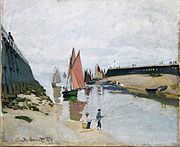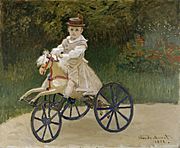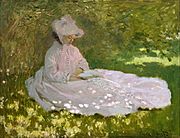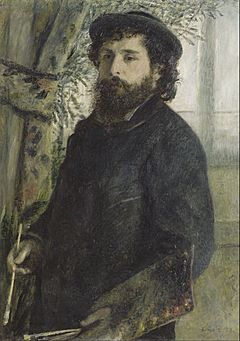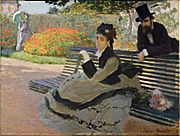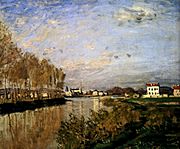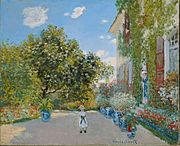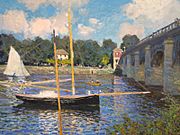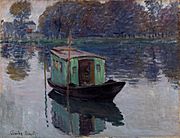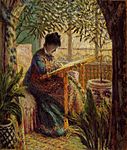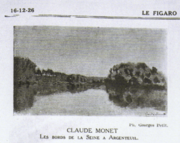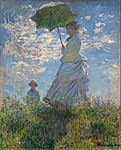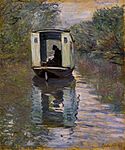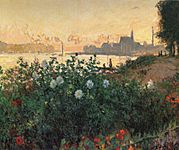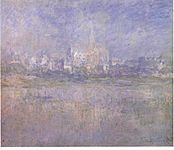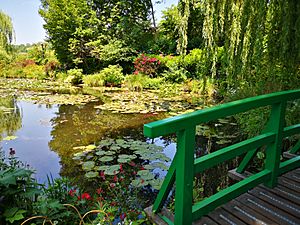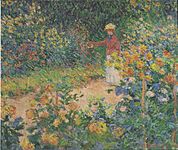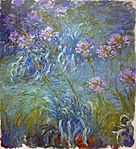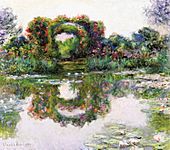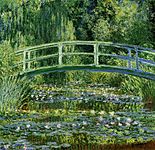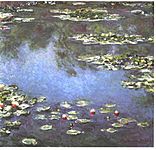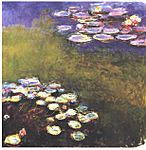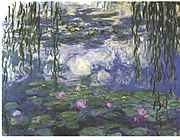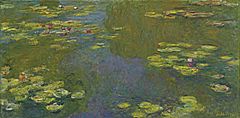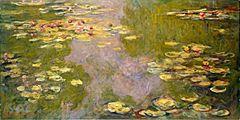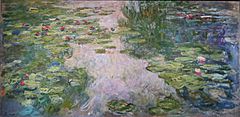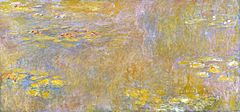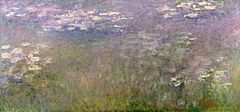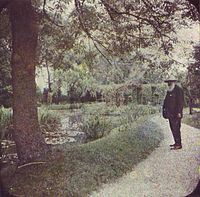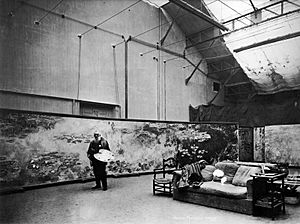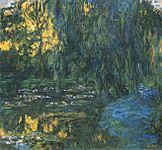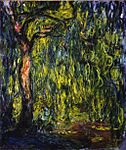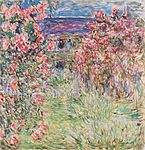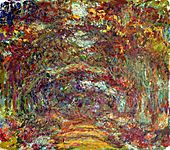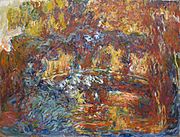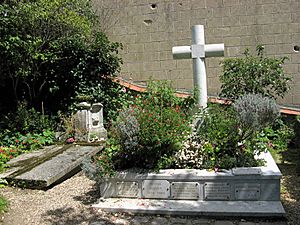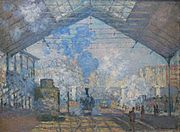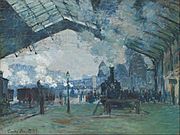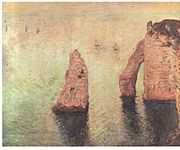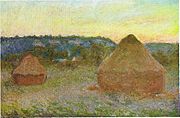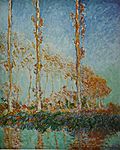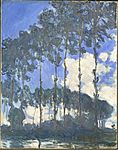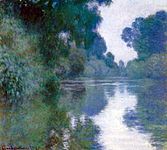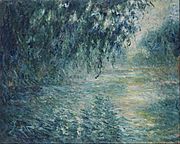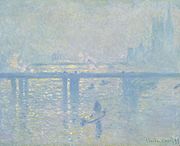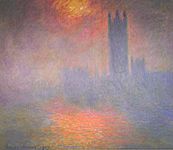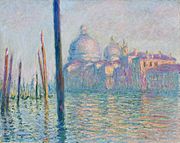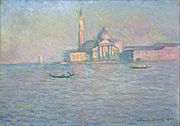Claude Monet facts for kids
Quick facts for kids
Claude Monet
|
|
|---|---|
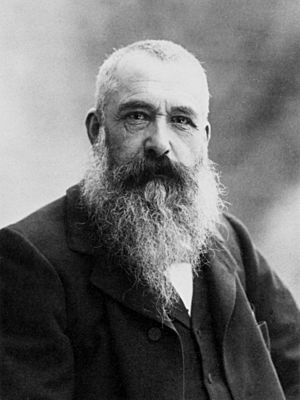
Monet c. 1899
|
|
| Born |
Oscar-Claude Monet
14 November 1840 |
| Died | 5 December 1926 (aged 86) |
| Education |
|
| Known for | Painting |
|
Notable work
|
|
| Movement | Impressionism |
| Spouse(s) |
|
| Patron(s) |
|
| Signature | |
Oscar-Claude Monet (born November 14, 1840 – died December 5, 1926) was a famous French painter. He is known as the founder of a painting style called Impressionism. The name "Impressionism" came from his painting Impression, soleil levant, shown in 1874.
Monet tried to paint nature exactly as he saw it. Throughout his long career, he always followed the idea of Impressionism. This meant showing how he felt about nature in his art. Some of his most famous paintings include his series of haystacks (1890–91) and paintings of the Rouen Cathedral (1894). He also spent the last 20 years of his life painting the water lilies in his garden in Giverny.
Contents
Monet's Early Life and Art
Claude Monet was born on November 14, 1840, in Paris, France. He was the second son of Claude Adolphe Monet and Louise Justine Aubrée Monet.
Monet grew up in Le Havre, Normandy. He became interested in the outdoors and drawing when he was young. His mother supported his dream of becoming a painter. However, his father wanted him to work in business instead.
In 1851, he started at Le Havre secondary school of the arts. He took his first drawing lessons from Jacques-François Ochard. Around 1858, he met another artist, Eugène Boudin. Boudin taught Monet how to paint outdoors, a style called "en plein air". Monet felt that Boudin taught him everything important for his later success.
Monet was very close to his mother. She died in January 1857 when he was 16. After her death, he went to live with his wealthy aunt, Marie-Jeanne Lecadre. His aunt supported his early art career.
Paris and Military Service
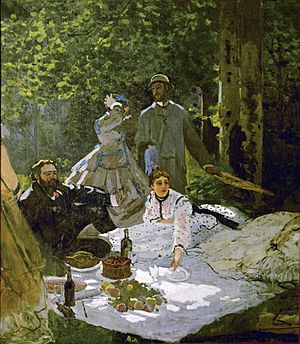
From 1858 to 1860, Monet continued his art studies in Paris. He joined Académie Suisse and met Camille Pissarro in 1859. His early paintings included landscapes, seascapes, and portraits. But they did not get much attention.
Monet was called to serve in the military service. He served in Algeria from 1861 to 1862. He returned to Le Havre because he became ill.
When he came back to Paris, his father allowed him to continue painting. He studied at Charles Gleyre's studio. There, he met Pierre-Auguste Renoir and Frédéric Bazille. Bazille became his closest friend.
During this time, Monet painted Women in Garden. This was his first successful large painting. He also painted Le déjeuner sur l'herbe, which was very important for his early career.
The Rise of Impressionism
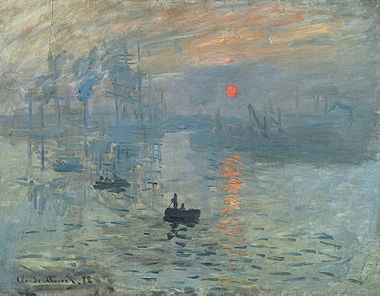
Monet was inspired by other painters like Pissarro and Édouard Manet.
In 1874, Monet showed his paintings at the first Impressionist exhibition. These included Impression, Sunrise, The Luncheon, and Boulevard des Capucines. An art critic named Louis Leroy wrote a harsh review. He noticed Impression, Sunrise (1872), which showed the port of Le Havre in a hazy way. He used the word "Impressionism" to describe it. At first, this word was meant as a joke, suggesting the painting looked unfinished.

Monet tried to sell Impression: Sunrise for 1000 francs, but it did not sell. Another exhibition was held in 1876. Monet showed 18 paintings, including The Beach at Sainte-Adresse, which showed many Impressionist features.
For the third exhibition in 1877, he chose seven paintings from his series of Gare Saint-Lazare train station. Critics liked these paintings. They especially praised how he captured the trains arriving and leaving. Monet's last time showing with the Impressionists was in 1882.
Monet, Renoir, Pissarro, and others started trying new ways to paint reality. They did not like the dark, strong lighting of older paintings. Instead, they used lighter colors, like those used by Jean-Baptiste-Camille Corot and Boudin. Monet's paintings from the early 1870s had a big impact on the Impressionist movement.
- Paintings from 1858–1872
-
Mouth of the Seine at Honfleur, 1865, Norton Simon Foundation.
-
The Green Wave, 1866, Metropolitan Museum of Art.
-
Women in the Garden, 1866–1867, Musée d'Orsay, Paris.
-
Woman in the Garden, 1867, Hermitage, St. Petersburg. This painting studies how sunlight and shadow affect color.
-
On the Bank of the Seine, Bennecourt, 1868, Art Institute of Chicago.
-
La plage de Trouville, 1870, National Gallery, London.
-
Springtime 1872, Walters Art Museum.
-
Ships Riding on the Seine at Rouen, 1872, National Gallery of Art, Washington DC.
Monet's Family Life
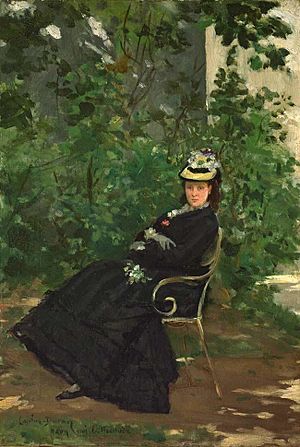
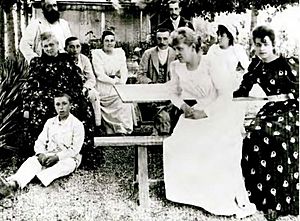
In 1867, Monet's girlfriend, Camille Doncieux, had their first child, Jean. Monet had met Camille two years earlier when she modeled for his paintings. Monet loved Jean very much. He even said Camille was his wife so Jean would be seen as his rightful son. Because of this relationship, Monet's father stopped giving him money.
Monet married Camille on June 28, 1870. He loved his family deeply and painted many portraits of them. One example is Child with a cup, a portrait of Jean Monet.
In 1876, Camille Monet became very ill. Their second son, Michel, was born in 1878. After Michel's birth, Camille's health got worse. She died the next year. Her death made Monet very sad and affected his work.
In 1892, Monet married Alice Hoschedé. She was the widow of a friend. Alice's third daughter, Suzanne, became Monet's favorite model after Camille.
- Paintings from 1873–1886
-
Camille Monet on a Garden Bench, 1873, Metropolitan Museum of Art, New York.
-
The Artist's House at Argenteuil, 1873, Art Institute of Chicago.
-
Coquelicots, La promenade (Poppies), 1873, Musée d'Orsay, Paris.
-
Argenteuil, 1874, National Gallery of Art, Washington D.C.
-
Vétheuil in the Fog, 1879, Musée Marmottan Monet, Paris.
-
Study of a Figure Outdoors: Woman with a Parasol, Facing Left, 1886, Musée d'Orsay.
Monet's Garden in Giverny
From 1883, Monet lived in Giverny, a town in northern France. He bought a house and property there. He then started a huge project to design and build a beautiful garden, including a water-lily pond.
Monet and his family worked hard on the gardens. His financial situation also began to improve. For 40 years, these gardens were Monet's biggest source of ideas for his paintings. In the 1890s, Monet built a greenhouse and a second art studio. This studio was large and had good light from skylights.
Monet wrote daily instructions for his gardener. He had exact plans for planting flowers. He also kept records of his flower purchases and his collection of botany books. As Monet became wealthier, his garden grew. He remained its designer, even after hiring seven gardeners.
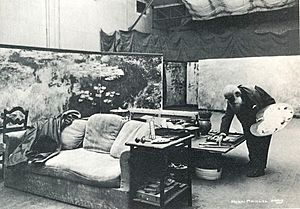
In 1899, he started painting the water lilies. These paintings would keep him busy for the next 20 years of his life. This series was his last and most ambitious group of paintings.
His paintings of water lilies often showed changing light and reflections on the water. These became a key part of his art. In 1909, Monet successfully showed his first Water Lilies series. This exhibition had 42 paintings. He would eventually create over 250 paintings of the Waterlilies.
- Garden Paintings
-
Agapanthus, between 1914 and 1926, Museum of Modern Art, New York.
-
Flowering Arches, Giverny, 1913, Phoenix Art Museum.
-
Water Lilies, 1906, Art Institute of Chicago.
-
Water Lilies, Musée Marmottan Monet.
-
Water Lilies, around 1915, Musée Marmottan Monet.
- Water Lilies Series
-
Water Lilies, 1919, Metropolitan Museum of Art, New York.
-
Water Lilies, 1917–1919, Honolulu Museum of Art.
-
Water Lilies, 1920, National Gallery, London.
-
Water Lilies, around 1915–1926, Nelson-Atkins Museum of Art, Kansas City, Missouri.
-
Reflections of Clouds on the Water-Lily Pond, around 1920, Museum of Modern Art, New York.
Later Years and Health
Monet's second wife, Alice, died in 1911. His oldest son, Jean, died in 1914. Jean had married Alice's daughter, Blanche, who was Monet's favorite. These deaths made Monet very sad. Blanche took care of him during this time. It was also around this time that Monet started having problems with his eyesight. He developed cataracts.
In the years that followed, his ability to see colors changed. His brushstrokes became wider, and his paintings looked darker. To help with his painting, he started labeling his paint tubes. He also kept his palette in a strict order and wore a straw hat to reduce glare.
He had cataract surgery in 1923. After the surgery, he could "see the real colors" again. He even started to destroy some paintings he made before the surgery. By 1925, his vision was much better. He began to fix some of his older works, making the water lilies bluer than before.
- Late Paintings
-
Water Lilies and Reflections of a Willow (1916–1919), Musée Marmottan Monet.
-
Weeping Willow, 1918, Columbus Museum of Art.
-
Weeping Willow, 1918–19, Kimball Art Museum, Fort Worth. Monet's Weeping Willow paintings honored French soldiers who died in World War I.
-
The Rose Walk, Giverny, 1920–1922, Musée Marmottan Monet.
-
The Japanese Footbridge, 1920–1922, Museum of Modern Art.
Death and Legacy
Monet died from lung cancer on December 5, 1926, at age 86. He was buried in the Giverny church cemetery. Monet wanted a simple funeral. Only about 50 people attended. At his funeral, his friend removed the black cloth from the coffin. He said, "No black for Monet!" and replaced it with a cloth covered in flowers.
Monet's home, garden, and water lily pond were given to the French Academy of Fine Arts in 1966 by his son Michel. After being restored, the house and gardens opened to the public in 1980 through the Fondation Claude Monet. The house has souvenirs of Monet's life and his collection of Japanese woodcut prints. Today, the house and garden, along with the Museum of Impressionism, are popular places for tourists in Giverny.
Monet's paintings became very famous and popular in the second half of the 20th century. He is now one of the world's most well-known painters. His later works helped connect Impressionism to 20th-century art and modern abstract art. Monet is now the most famous of the Impressionist painters.
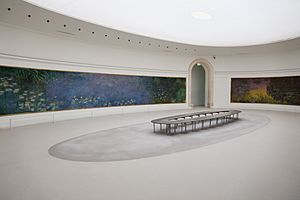
In 1978, Monet's garden in Giverny was restored and opened to the public. In 2004, London, the Parliament, Effects of Sun in the Fog (1904) sold for over $20 million.
One of his paintings, Falaises près de Dieppe (Cliffs Near Dieppe), was stolen twice. It was taken in 1998 and again in 2007. It was found and returned in 2008.
On November 14, 2001, Google Doodle made a special logo for Claude Monet's 161st birthday. It showed the Google logo in Monet's painting style. This was the first Google Doodle made for someone's birthday.
Monet's painting Le Pont du chemin de fer à Argenteuil, from 1873, sold for a record $41.4 million in 2008. A few weeks later, Le bassin aux nymphéas (from the water lilies series) sold for over $80 million. This was one of the highest prices ever paid for a painting at that time.
In 2013, some of Monet's paintings, L'Eglise de Vétheuil and Le Bassin aux Nympheas, were part of a legal case. They were linked to money that was said to be taken from a country's funds. The government of that country is trying to get the paintings back.
Art Stolen During War
During World War II, many artworks, including paintings by Monet, were stolen from Jewish art collectors. This happened in Germany and other countries occupied by Germany. Some of these stolen artworks have been returned to their original owners. Others are still part of court cases today. For example, in 2014, a Monet painting that belonged to a Jewish businessman was found hidden in a suitcase.
Some examples of Monet's works that were stolen during this time include:
- La Seine à Asnières/Les Péniches sur la Seine
- Le Repos Dans Le Jardin Argenteuil
- Nymphéas
- Au Parc Monceau
- Haystacks at Giverny
Interesting Facts About Claude Monet
- Monet was given the name Oscar-Claude at birth, but his parents called him Oscar.
- Even though he was baptized Catholic, Monet later became an atheist.
- Monet started drawing funny pictures of people he knew when he was 15 years old to earn money.
- Monet often had money problems and sometimes could not pay his bills. Once, his paintings were taken by people he owed money to. A shipping merchant named Gaudibert bought them back for him.
- During the Franco-Prussian War, he and his family lived in London and the Netherlands to avoid being forced into the army.
- During World War I, his younger son, Michel, served in the war. Monet painted a Weeping Willow series to honor the French soldiers who died.
Images for kids
- Series of Paintings
-
La Gare Saint-Lazare, 1877, Musée d'Orsay.
-
Arrival of the Normandy Train, Gare Saint-Lazare, 1877, The Art Institute of Chicago. Part of Monet's Gare Saint-Lazare series.
-
Grainstacks, end of day, Autumn, 1890–1891, Art Institute of Chicago.
-
Poplars at the River Epte, 1891 Tate, London.
-
The Seine Near Giverny, 1897, Museum of Fine Arts, Boston.
-
Morning on the Seine, 1898, National Museum of Western Art, Tokyo.
-
Charing Cross Bridge, London, 1899–1901, Saint Louis Art Museum.
-
Two paintings from a series of The Houses of Parliament, London, 1900–01, Art Institute of Chicago.
-
London, Houses of Parliament. The Sun Shining through the Fog, 1904, Musée d'Orsay.
-
San Giorgio Maggiore at Dusk, 1908, National Museum Cardiff, Wales.
-
San Giorgio Maggiore, 1908, Indianapolis Museum of Art.
See also
 In Spanish: Claude Monet para niños
In Spanish: Claude Monet para niños


